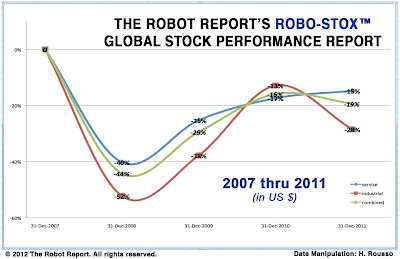 |
| Click image to enlarge |
The latest ROBO-STOX™ chart – covering the four year period from 12/31/2007 to 12/31/2011 – shows that worldwide stock performance of robotic stocks over the last four years has been disappointing for investors.
- Robotic industrials are still down 28% from their 2007 highs and did poorer than the Dow Jones Industrial Average which is also down 8.5% from 2007.
- Service robotic stocks are down 15% from 2007 while the NASDAQ is down just 2.5% — better than the industrials, and showing signs of steady improvement, but still hasn’t regained their 2007 highs.
- Industrials took a big fall from their 2007 highs with the doubly whammy of the collapse of auto sales and bankruptcies of auto companies. 2009 saw hesitation and some gains, and then a small rise in the latter part of 2010 was blown away with the Japanese disasters, Thailand floods and EU economic turmoil. Thus industrial robot stocks are still down 28% even though business is good.
- The few publicly-traded service robotics companies fall into three main sectors: medical, defense/security and a mixture of academic and consumer niche products. Medical robotic stocks are booming; defense/security stocks are holding steady; and the remainder are all over the place.
- Industrial robot companies represent 62% of the $9.3 billion robotics industry revenue; service is 38% of which 75% was for military/defense (data provided by International Federation of Robotics in their 2011 reports and press releases).
Publicly-traded robot vendors represent less than 20% of the total list of companies in the industry. Further reducing that number of stock opportunities is the fact that in many cases, robotics is not the primary business of the company. ABB (ABBN:VX) is an example – only 1/3 of their income is derived from robotics or robotic related activities; the same is true for many of the public companies, particularly those that provide drones for defense and underwater ROVs.
2012 is likely to be another volatile year for robot vendors, public and privately-held.
- In the industrial sector, Foxconn (2317:TW) has confirmed that their new robot manufacturing facility in Taiwan will be producing about 1 million robots for deployment in their factories in China starting this year and continuing into 2013 and 2014. Foxconn’s choice to build their own robots will have a major impact on robot manufacturers ABB (ABBN:VX), Fanuc (FANUY) and Kuka (KU2:GR) – companies that have manufacturing facilities in China or nearby and were anticipating selling to Foxconn.
- Foxconn has not said whether or when they will begin selling their new line of robots to other companies.
- Medical robot vendors outside of the U.S. will find much demand for their products which are likely to be unhampered by FDA and other regulatory bodies, eg, Mazor (MZOR:IT), an Israeli company with a well-received robotic device for spine surgery. In the U.S., competition and growth is thwarted not only by the slow and costly FDA approval process but also by Intuitive Surgical (of da Vinci fame) (ISRG) and InTouch Health (venture-funded; not yet public), both of which have wide-ranging patents.
- Defense/security robot and unmanned vehicle vendors (air, land and sea) worldwide will find their products in much demand even though overall defense spending is going down.
- Robot vacuum vendors like iRobot (IRBT), LG and Samsung, are finding that world demand for this type of robot cleaner is growing – but so is the competition. At CES 2012 there were 6 other Korean, Chinese and European competitors to the big 3.
- Robotic lawnmowers are beginning to sell as their price comes down to less than $1,000 in the U.S. and less than $2,000 in Europe.
- Service robot companies that focus on academia will find much competition and lower budgets for the year.
- Engineering and consulting firms that provide automation integration services will start to feel pinched as robot manufacturers provide robots which are more intuitive and easier to train and integrate – the very reasons that caused there to be a need for outside integrator firms in the first place.
Consequently, for the robotics industry, all the ancillary businesses and all their stocks, I see 2012 as a year similar to 2011 (hopefully without the natural disasters of 2011), with bouts of sharp volatility but minimal upward growth.





Tell Us What You Think!